View current page
...more recent posts
Old School Techno from Dallas, Part 2
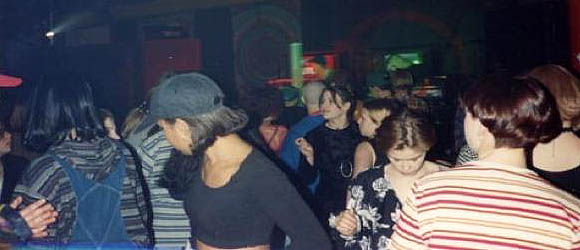
Ravestock '94, Dallas. That is seriously a lot of stripes. And girls.
x-eleven "Ecstasy" 1992 [mp3 removed]
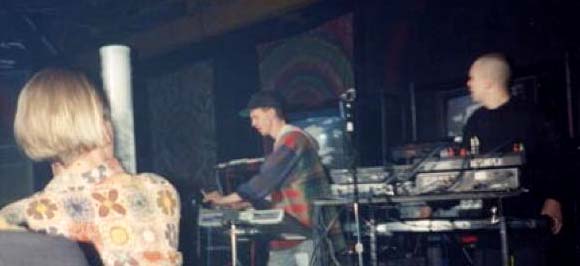
Previous post on x-eleven is here. Since it was written, Gary Wicker has put up some more tracks, including "Ecstasy," the one highlighted above. Not sure where it's going at first, the sampled "ooh" sounds silly, but at the 90 second mark it grabs your attention, and at 120 seconds, when the Larry Heard-ish house part with the synth-flute kicks in and those "oohs" become joyful, stuttering vocal science, it really takes off. Some of the appeal is rooted in time travel but this is among the happiest music you'll hear, and Wicker feeds the retrograde desire to hear lots of arpeggios played at high speed. Haven't checked out Todd Hixon's videos yet, also from the vault, but will--just wanted to get this track up. It's weird, I'm nostalgic for a scene I never participated in, except in my studio listening to these tunes on the radio. I moved to NY the next year and found drum and bass everywhere--right about the time Wicker sold his gear and stopped making x-eleven tracks. "Ecstasy" is earlier--'92. Update, December 2014: The X-Eleven links above are dead but the group has a page on bandcamp.
I'm trying to set up a music studio and it's slow and frustrating as hell. There's a reason I use simple-minded programs in my visual work--I want the tech to be fast and uncomplicated, and then I compensate by doing something ridiculously labor-intensive on the physical end. So far I've had a similar approach to music, somewhat in reverse: using entry level programs and the computer's sound card but mousing in the entire composition note by note on an old fashioned staff. One of my family members said, "Yeah, but it's the same four notes over and over!" I tried to explain that there are timbral variations that make the work similar to my sphere paintings, which this person likes, and exciting octave jumps, and subtle things with syncopation, and...well.
The problem is I'm tired of the textures of the low end music programs and want the sound to get richer. I love the Sidstation synthesizer I bought recently and think it deserves better accompaniment than the sound card synths in the shareware program I downloaded. I'm tired of buzz and hum in the recording. I want better bass and drum sounds. I want a real sequencer.
Before Christmas I bought a sampler from craigslist: an E-mu E6400 Classic. I've been playing with it tonight and it's been fun learning how a 9 year old sampler works but, actually, I'm not sure it does work. I managed to record a 1-second sample but couldn't save it. This machine has no internal hard drive, so my options are to hook a scuzzy (SCSI) cable up to a zip drive or CD ROM, neither of which I have, get an adapter card and enter "Scuzzy Hell" trying to get my PC to read it, or use the floppy drive to store small bits of data. Watching this thing slo-o-owly format a floppy was discouraging, and then I couldn't save to it. After 3 tries I successfully named a "bank," but then the sample wouldn't go in it. Eventually I turned off the machine and lost the sample.
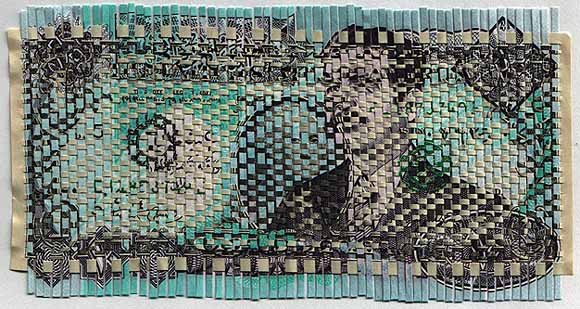
Oriane Stender, Dinars to Dollars (woven dollar bill and 10 dinar note)
David LaChapelle, he of the horrible stagy photographs, has sniffed out the latest ghetto thang: "krumping" or "clown dancing." It sounds intense and fun to watch, as described in Forward Retreat's review of LaChappelle's film documentary on the trend. ("More lyrical than the rock/pop jerks of breakdancing, clowning and krumping involve a level of physicality so intensely rhythmic that one could mistake dance practice for a gang fight. Combining hip hop, breaking, the martial arts and strip dancing techniques--just to point out a few more recognizable influences--young dancers pump their booties like machine gunfire.") The blog then issues a challenge:
Go ahead, let it rip. Scream "cultural appropriation" and run wildly through the halls of the nearest University's Anthropology department. Deride LaChappelle as a slutty Vanity Fair-contracted commercial photographer. Then see Krumped, and prove yourself wrong.Cultural appropriation will likely occur at the MTV, DVD, McDonald's movie tie-in level, given the entertainment industry's inability to produce anything original--this sounds like a natural. Where LaChappelle "bravely" led, others will follow. The challenge perhaps ought to be--how long before white kids in the burbs are doing this? Six months? A year?
I herewith offer a related counter-trend which, lacking the potential for shots of tight youthful buns, will never be as big as krumping: Kaiju Big Battel (sic). From the Boston Phoenix: "Kaiju, which means 'mysterious beast' in Japanese, is a Boston-based monster-wrestling league that stages full-scale matches, contests, and tournaments...[i]nfluenced by Japanese anime, World Championship Wrestling subplots, and the kitsch of dubbed monster-movie cult classics like Ultraman..."
more pics / more Boston Phoenix (hat tip to Kristin for the link.)
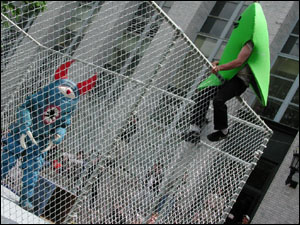
UPDATE: T.Whid politely suggests that KBB is old news but I say it's never too late to pose anything as a counter-trend to David LaChappelle.
Fuzzy think piece in the NY Times today here on the Tsunami and what it all means. A good discussion of how cataclysmic seismic events seem to come in clusters lies sandwiched between the contentious headline "The Year the Earth Fought Back" and some spurious riffing on the Gaia hypothesis, which holds that the entire world is a living organism.
The key word there is "living." To imply that the molten rock under our feet is an active (as in volitional) part of Gaia takes us a bit further back into animist mysticism than most of us should want to go. In other words, the headline and thesis might be intuitive if 100,000 had died as a result of disease or sudden release of organic chemicals into the air. That could indeed suggest that Gaia has "fought back" against our sloppy stewardship of her--that she is self-regulating to correct damage one of her component species causes.
Yet surely if Gaia exists it is in the community of living matter hugging an inhospitable ball of nickel-iron like a skin, not the ball itself. The ball's mistreatment of the skin may very well come in peristaltic spurts of volcanos and earthquakes, but the skin adjusts to that over the eons. Rock responds to the biosphere, too, of course, but lightly, in the form of erosion. To say that the biosphere sent a signal to the rocks to deform themselves and punish mankind is Old Testament hogwash--turning a nurturing mother back into the man with the spear.
More Damned Metablogging
Many thanks to Raphael Rubinstein for his nice piece on art blogs in the January 2005 Art in America, and for tossing this page into the mix. Dan at Iconoduel, another tossee, posted searchable text here, and still another, Joy Garnett at NEWSgrist, put up a scan. Garnett related the AinA piece to the recent Rhizome.org panel on art blogs I and other bloggers participated in, and also a research paper titled "Art Blogs: Why Such a Timid Emergence?" by Marie Omann, a masters degree student in Design, Communication and Media at the IT University of Copenhagen, which is published in .PDF form on T.Whid's and M.River's blog.
The panel and the paper tended to concentrate on how practicing artists use blogs, while Rubinstein focused more on the growing field of blog-style art journalism. Omann imposed especially tight criteria for her research subjects, requiring that the blogs be written by artists in their role as artists, have artistic content, and be updated daily. She then triangulated this activity within current sociological and media theory about the internet and its budding communities.
In brief, Omann mostly shrugs off the old-school Marxist view of Modernity as a community-destroying blight and posits art blogs as an example of "liberated communities," that is, "sparsely knit and territorially unbound communities based on individual choices." (Think fan clubs and terrorist cells.) Before the Internet, these "geographically dispersed social networks" already existed in our highly mobile, wired society--even participation in a biological family unit is increasingly seen as voluntary when its members live in different cities.
As for how well blogging fits into all this, let's just say my two cents were quoted at length so of course I think her arguments are great. But as I told Omann in a thank you email, she possibly oversold the idea of community within the world of visual art online self-publishing. Fault lines exist within this global village that are actually gaping, sulphurous chasms patched over with hopeful cyber-cement. Here are just a few of the divisions:
Print journalism (and its online variants) vs blogs. A subject of endless, mostly angry fascination among the art-journo-bloggers, and while Rubinstein has extended the olive branch of reciprocal fascination, it should probably be greeted with haughty skepticism. Just kidding, of course.
New York vs everywhere else. Another subject of endless fascination outside New York, but tedious to read. The discourse needs to rise above the level of lame us vs them conspiracy theories.
Artists vs non-artists. Shop talk steers the bus but others are welcome to listen in and back seat drive, assuming that's OK with James Elkins.
Gallery art vs new media art. Can anyone argue across this divide? Will the former please pay attention to the latter and will the latter please stop obsessing about not being paid attention to?
Blogging about art vs other stuff. It's silly to limit yourself to one subject in a medium that can tie you into any discourse at the click of a hyperlink.
This page promises to work hard to widen all these nascent, still largely unspoken rifts within the so-called community of so-called art blogs. In a friendly way.
Update: edited slightly to clarify that "NY vs Everywhere Else" whining is tedious universally, not just to New Yorkers. I hated it long before I lived here.
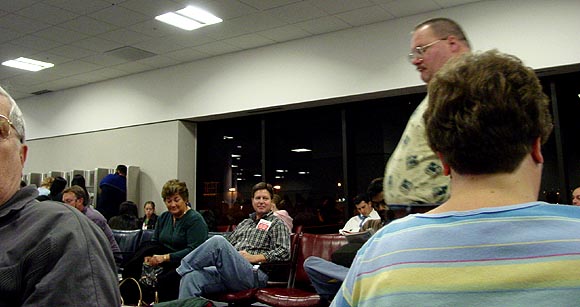

Atlanta airport, December 23, 2004. Delta flight took off 5 1/2 hours later than scheduled.
More impressions of the "Scratch Code" exhibition at bitforms, presenting computer art from the '50s, '60s and '70s. Paul asks about the Peter Vogel sculpture: I'd say its appeal is more technological than artistic--or perhaps, it's better as sound art than visual art. This gets back to an earlier post about circuit bent work being problematic as sculpture. The best work looks like it emerges casually and offhandedly as a result of a technologist trying to create a certain set of sounds, that is, as sloppy mad scientist bricolage, but as soon as it becomes self-consciously "artistic" or "sculpture-like" it loses, um, juice. Vogel has made a little cage of soldered metal sticks holding wires, capacitors, transistors, etc that cheeps and bleeps as you move around it. All the circuitry is exposed and you can visualize a certain set of probabilistic variables creating that sound even if you know nothing about electronics. The sounds are fascinating but the sculpture has to stand next to say, David Smith, who kind of set the standard for freestanding modernist sculpture, and it rather ignores all his hard work and the dialogue he participated in in favor of "making shit up"--i.e., presenting an unengaging, upright column-shape with the spidery, solder-y metallic textures of modernist knockoff mall art, or church or synagogue art. You can enjoy it on that level but you have to view it with kitsch filters firmly in place.
Manfred Mohr's prints in the same show, however, seem neither cheesy nor dated, perhaps because they are Ultimately Minimal and not trying to be expressive. They speak purely and eloquently to a techno-design-acclimated generation conversant with the likes of Designers Republic CD covers; they could also be cool scores for music by glitch-and-hiss musicians. Carsten Nicolai's spare, scrupulous visual work also comes to mind.
